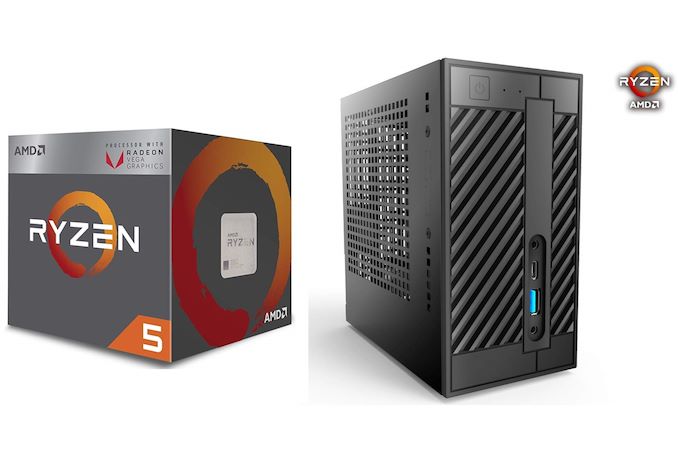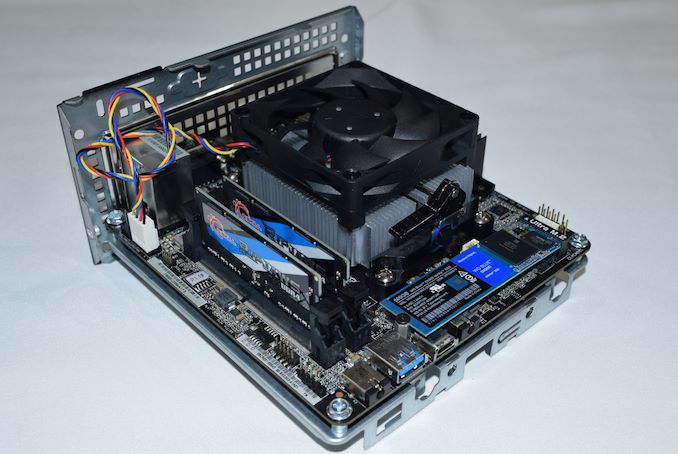The ASRock DeskMini A300 Review: An Affordable DIY AMD Ryzen mini-PC
by Ganesh T S on April 26, 2019 8:00 AM ESTClosing Thoughts
Throughout this review we've taken a comprehensive look at performance of the DeskMini A300 for a range of SFF PC workloads. It is now time for some closing thoughts from two perspectives - the Ryzen 5 2400G APU, and, the DeskMini A300 motherboard and chassis combination.
SFF machines are popular as space-savers in office environments. For typical office productivity and business workloads, we see that the BAPCo benchmarks and PCMark 8 approximately lead to the same conclusions. The energy consumption metrics show that Intel-based solutions are delivering better performance per watt for equivalent performance. However, the Ryzen-based solutions have lower upfront costs for the same performance. Meanwhile the PCMark 10 overall score shows the Ryzen 5 2400G in much better light because of the inclusion of 3DMark GPU workloads as contributors to the score.
If a PC with gaming credentials is required and the budget doesn't allow for a discrete GPU, a Ryzen APU like the Ryzen 5 2400G is simply the only choice. There are no ifs, ands, or buts here. Even the most powerful integrated GPU that Intel can offer (Intel Iris Plus Graphics 655) is way behind the Radeon RX Vega 11 in the Ryzen 5 2400G. This is across all our gaming benchmarks, irrespective of the quality settings or resolution. The reason for this is easy to infer from our thermal stress tests. With the GPU alone active, the DeskMini A300 draws more than 65W at the wall. In comparison, the most powerful Intel iGPU-equipped system - the Bean Canyon NUC - draws 48W in the same scenario. The corresponding number for the DeskMini 310 with the Core i3-8100 is around 42W. The Radeon Vega architecture and the APU design allows for a much higher power budget for the GPU compared to Intel's designs. All these contribute to the excellent graphics performance of the Ryzen 5 2400G.
On the multimedia front, unfortunately a Ryzen APU-based SFF PC is not advisable for anything beyond the most casual of uses. The hardware itself is actually rather capable (as noted above), but the the current state of the Radeon drivers holds it back. Overall, as a vanilla 1080p playback machine with minimal DRM requirements (read, playback of YouTube videos and basic Netflix streaming), it can do a decent job (assuming power efficiency is not a big factor). However, as soon as we get to more contemporary or arcane requirements (Netflix with 4K HDR, VP9 Profile 2 playback with open source software like VLC or MPC-HC, or UHD Blu-ray support), we run into driver issues or hardware limitations, as described in the HTPC sections.
These sorts of compatibility issues are disheartening to see, given that the system natively supports 4Kp60 output on the HDMI port with HDR. The true HDMI 2.0a output is is contrast to Intel's native HDMI 1.4a output (which has to be worked around with an extra board component by OEMs wanting to provide a HDMI 2.0 port in their system). Folks looking to build a modern media consumption-centric HTPC should look at Intel-based platforms such as the Bean Canyon NUC. The silver lining here, at least, is that these appear to be software issues; so AMD has an opportunity to fix these problems (and change our minds) in future driver versions.
Moving on to our choice of other build components in the DeskMini A300, we first talk about the Western Digital WD Blue SN500 NVMe SSD. Despite its PCIe 3.0 x2 interface, the performance per dollar metric, as well as its general consistency, is excellent. The 500GB version we used in our build is available for as low as $65. This complements the cost of the DeskMini A300 ($190 or $150) and the Ryzen 5 2400G ($150) when attempting a budget build. We did splurge a bit on the RAM, opting for the G.Skill Ripjaws Series DDR4 SODIMM rated for 3000 MHz operation (2x $50). The reason to not go in with SODIMMs operating at lower frequencies was to ensure that we were able to provide the APU with more that the bandwidth available at its rated memory clocks (DDR4-2933) while not losing out much on the latency front. With its 16-18-18-43 timing configuration, the G.Skill Ripjaws series DDR4-3000 kit represented the best balance of price, bandwidth, and latency.
Coming back to the DeskMini A300 itself, the chassis is the same as what we have seen in the previous DeskMini 1.92L machines. It will not win any industrial design awards, but it is functional enough. It has plenty of ventilation to aid in dissipating the heat from the board components. The external I/O and the internal board slots represent the best that can be done with the A300 Promontory chipset. Without spare PCIe lanes, the board can only have the NVMe, SATA, and USB ports driven directly by the Ryzen APU + chipset. That is still enough to provide plenty of storage options on the motherboard (given its mini-STX size), but additional USB ports would really be nice to have. ASRock should have included the dual USB 2.0 header cable (currently optional) as part of the package. The DeskMini A300 scores over the comparable Intel-based DeskMini 310 system by including a second M.2 NVMe SSD slot. However, it doesn't have the microSDXC slot available in the latter. In terms of external I/O capability, the two budget mini-STX PCs are equivalent.
Overall, the DeskMini A300 is one of the first AMD-based SFF PCs in the market. And while the SFF situation with AMD's Ryzen APUs is still a uneven at this time, it's still proven a capable system that we can recommend for specific usage scenarios. Particularly, if the PC is expected to service any type of gaming/graphics workload, it provides way more performance compared to any Intel-based alternative at similar price points (i.e, ruling out the use of a discrete GPU). For traditional office and business workloads, it gets the job done; and while it's not particularly energy efficient, the upfront cost itself is lower.
In other words, as is often the case, there are pros and cons to the DeskMini A300. It's a rather capable machine when playing up its strengths, but potential buyers will definitely want to first make sure their workloads are a good fit for what the SFF PC can offer.












88 Comments
View All Comments
Thvash - Friday, April 26, 2019 - link
For some reason 4K HDR, VP9 Profile 2 is not accelerated at all under Windows, while GPU claims to support it, no such issues under LinuxSmell This - Friday, April 26, 2019 - link
**Microsoft removed the in-built HEVC decoding capabilities of Windows 10 in the 2017 Fall Creators Update, and replaced it with an extension that had to be downloaded from the Microsoft Store. Without the extension, playback is restricted to 1080p non-HDR streams encoded in H.264. In addition to the decoding capabilities, the system also needs to support PlayReady 3.0 DRM.**______________________________________
Ding!
Another drive-by DRM borking by WIntel ...
Ratman6161 - Monday, April 29, 2019 - link
This doesn't come with an OS, so if you hate Microsoft so much, then don't use Windows. As far as DRM goes, support for it is a necessary evil to avoid being sued. So it's not a "borking by Wintel", its a symptom of our lawsuit happy society + rampant piracy that the owners of intellectual property feel they must defend themselves against.mapesdhs - Thursday, May 2, 2019 - link
Wow, talk about buying MS' spin. Amazing how people are so happy to throw away their freedoms. In reality the blatant abuse of consumer IP rights is far more important but rarely addressed.https://www.youtube.com/watch?v=tUAX0gnZ3Nw
peevee - Thursday, May 2, 2019 - link
"In reality the blatant abuse of consumer IP rights"You have NO rights to OTHER PEOPLE'S Property. Intellectual or not.
ripbeefbone - Thursday, May 2, 2019 - link
I miss the 90s when nerds weren't embarassing bootlickers who fawned over corporations. get a soul you shillspeevee - Monday, May 6, 2019 - link
I was the nerd in the 90s (and 80s) and still supported patents and copyrights. While violating some of them.airider - Thursday, May 2, 2019 - link
Interesting perspective. Intellectual property is not defined anywhere. It is a made up term assigned to copyrighted material and patents. If you live in the U.S. these are protected by Article 1, Section 8, Clause 8 of the Constitution:“To promote the progress of science and useful arts, by securing for limited times to authors and inventors the exclusive right to their respective writings and discoveries.”
The "right" to IP is only guaranteed for a limited time. When this time expires, the "right" no longer exists and it becomes public domain.
airider - Thursday, May 2, 2019 - link
In fact, the reason these legal definitions exist is because copyright material and patents are not property, but rather the expression of ideas and thoughts through various forms of media (i.e. verbal, visual, etc).Because expressions are not property, a legal construct was created in order for "expressionists" to protect their ability to "make money", since once they expressed themselves, the expression is no longer their own, and the ability to profit was no longer in their control.
sorten - Tuesday, May 21, 2019 - link
I was also a nerd in the 80's (and still today) and have never thought it was cool to steal others' creations. If you do that on a large enough scale then there's no incentive left for creative types to create, and what a unhappy world that would be to create.